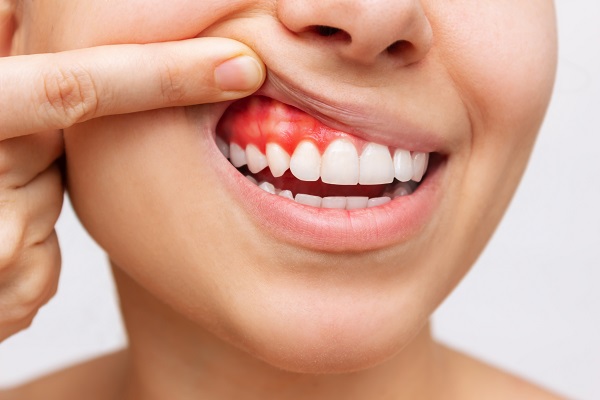A Periodontist Describes Common Signs of Gum Disease

Patients who seek treatment from a periodontist for gum disease are often surprised that the condition does not always cause pain. Although gum disease is may be painless, other signs can prompt treatment to prevent tooth loss.
What is gum disease?
Gum disease, or periodontitis, starts with a buildup of bacteria-filled plaque along the gum line that causes gingivitis. Gingivitis causes inflammation and bleeding of the gums, but it does not affect tooth stability and is reversible through proper oral hygiene. However, bacteria can reach below the gum line if left untreated, causing infection, which compromises the jawbone and tissues that support the teeth.
What are common signs of gum disease?
A periodontist can educate patients about how to identify gum disease that requires urgent treatment. Patients should not ignore the following signs, which are often painless and subtle.
Bleeding gums
Gums that occasionally bleed during brushing and flossing may result from overly rigorous home care, but chronic bleeding, even if slight, indicates gingivitis, the earliest form of gum disease. Fortunately, at this stage, it is possible to prevent periodontitis or advanced gum disease with better oral hygiene habits, including regular in-office dental cleanings.
Red and swollen gums
Overzealous brushing and flossing or using a hard-bristled toothbrush can cause red and swollen gums. Gum disease might be the culprit when the condition does not resolve following adjustments to oral care techniques.
Receding gums
Gum recession has many causes, including:
- Excessive force while chewing due to bite misalignment
- Extreme pressure from teeth grinding
- Aggressive brushing that wears away tooth enamel
- Tartar buildup at the gum line from tobacco use
Gum recession may also signify gum disease. For example, a bacterial infection can take hold of the gum line and wear away the gums. Gum recession may also indicate that bacteria are reaching and destabilizing the underlying tissue and jawbone, which might eventually lose the ability to support the teeth.
Changing bite and loose teeth
Changes to bite can affect eating and chewing. Patients who detect an awkward bite or whose teeth can not tolerate the force of chewing should consult with a periodontist for a gum disease assessment. Bite changes and loose teeth are common signs of bacterial destruction of the jaw bone, leaving it unable to support teeth adequately.
Bad breath
Although digestive issues and food choices often lead to bad breath, a consistent problem could signify an entrapment of food particles between the gums and the teeth. Without removing the particles through daily home care and in-office cleanings, bacterial pockets that produce a foul odor can quickly form.
Pus
The body produces pus to combat infections, and pus that oozes from between the teeth is a definitive sign of gum disease that requires urgent treatment. If the pus cannot drain, it will accumulate in a pocket that protrudes from the gum.
Conclusion
A periodontist can determine the appropriate treatment for gum disease to prevent tooth loss. Patients should be aware of common signs of gum disease to ensure early intervention while the condition is still reversible.
Request an appointment here: https://www.montgomerycountyperio.com or call Montgomery County Periodontal Associates at (281) 404-7548 for an appointment in our The Woodlands office.
Check out what others are saying about our services on Yelp: Read our Yelp reviews.
Related Posts
Gum grafting is a dental procedure to treat gum recession, where the gum line recedes exposing more of the tooth or its root. This condition can cause sensitivity, increased decay risk, and aesthetic concerns. Gum grafting techniques restore gum tissue to its original form to correct this issue.Gum grafting is the addition of tissue where…
A periodontist can treat various stages of gum disease, from gingivitis to periodontitis. Learning the answers to these common questions about gum disease can help patients understand when periodontal care is needed to achieve good oral and general health. Gingivitis is a mild and reversible form of gum disease that leads to swelling, redness, and bleeding…
An oral pathology must receive immediate treatment. This can prevent more complications later on. Your oral surgeon can help correct any dental problem. Here are the details about each common oral pathology and its corresponding treatment.This oral pathology results from a bacterial infection because of plaque buildup. Symptoms of this condition include gum bleeding and…
Are you considering getting a dental implant from a periodontist? Dental implants, also known as endosseous implants or fixtures, are a great solution for people who have lost teeth due to injury, disease, or decay. They can provide a long-term, stable solution for replacing missing teeth, and the process of getting an implant from a…
